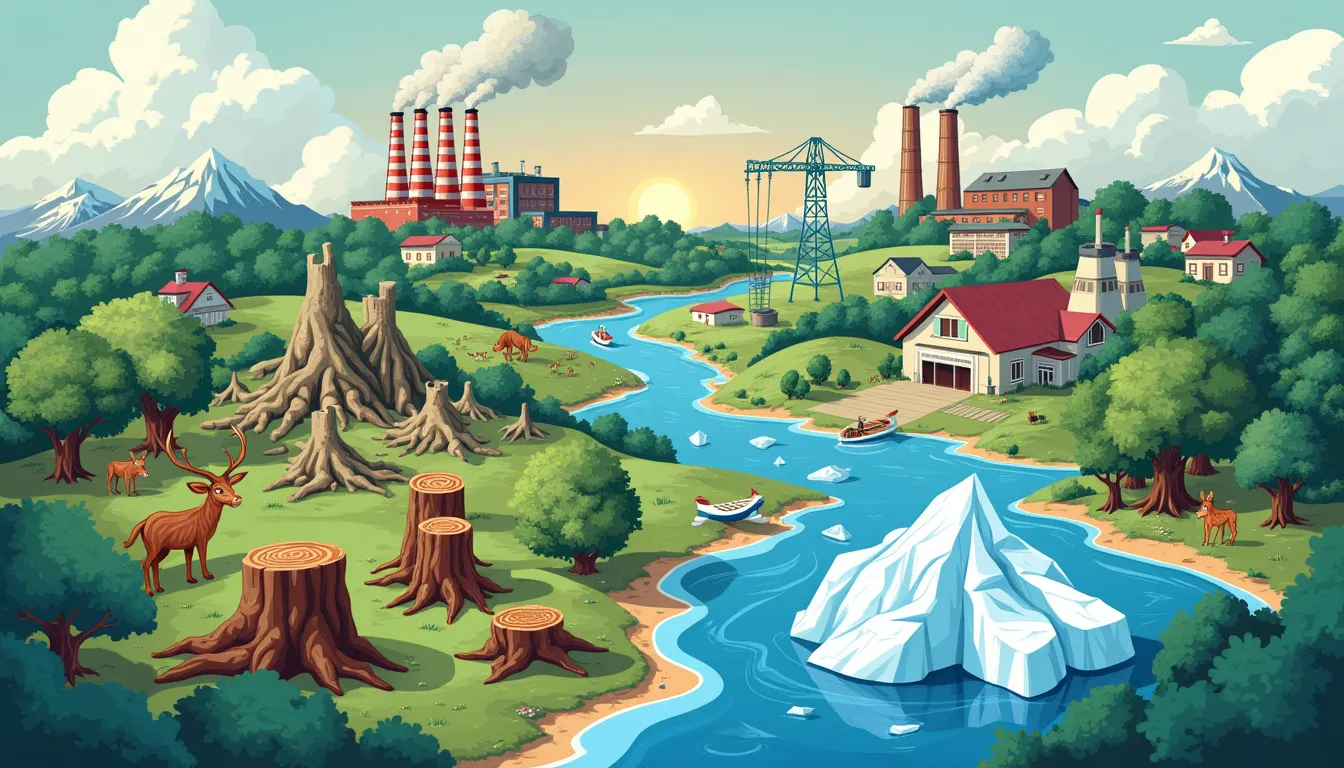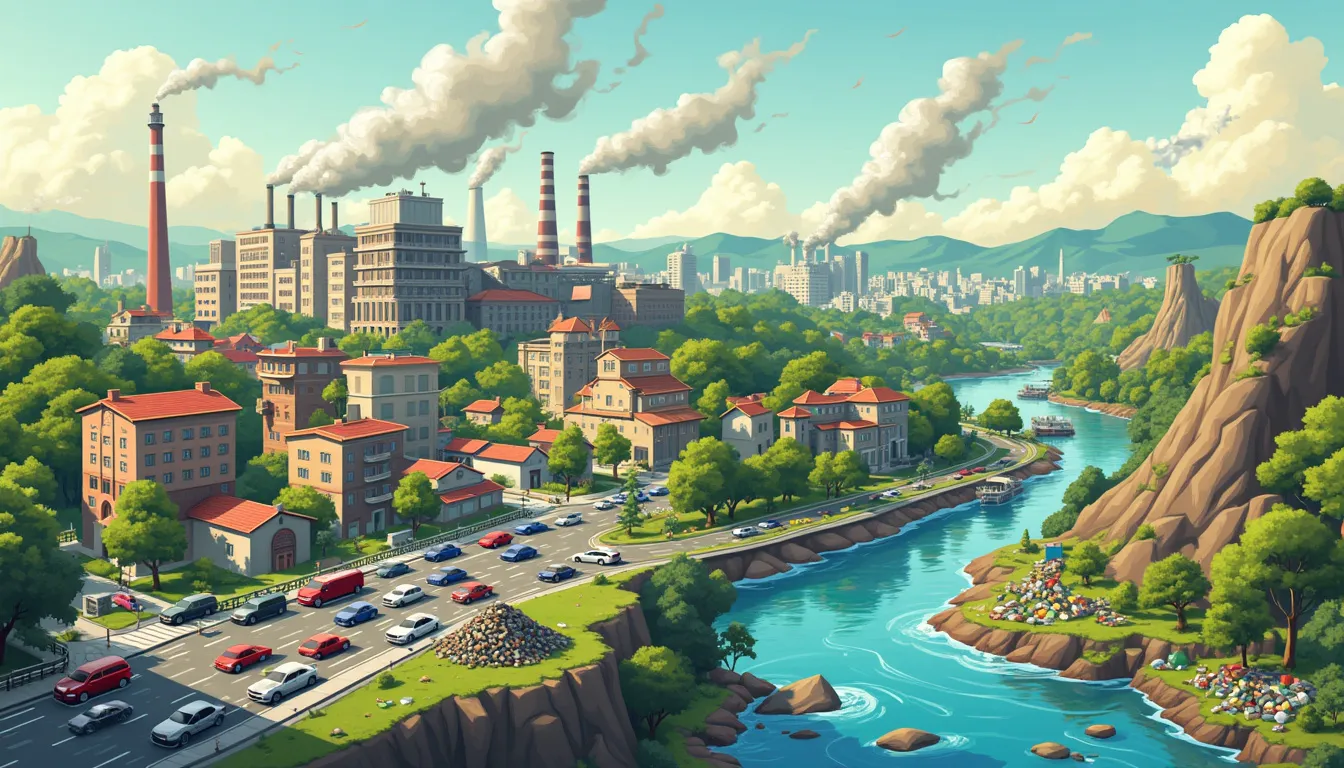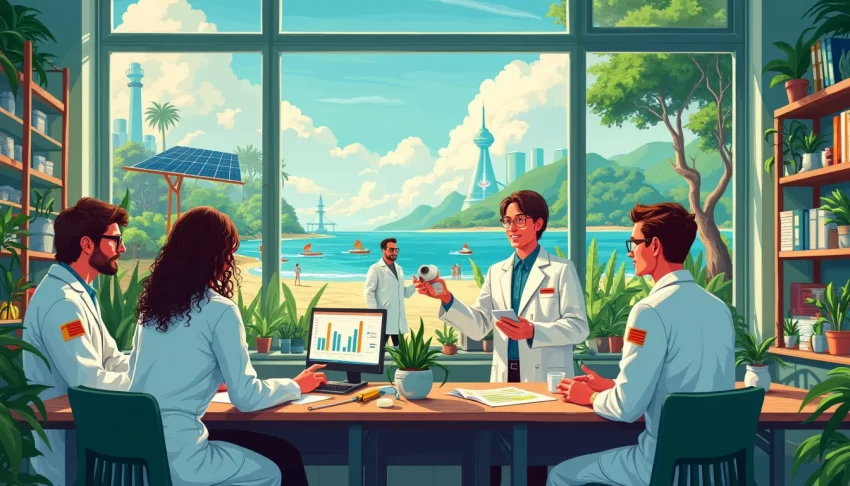In today’s fast-paced world, the urgency of addressing environmental problems has never been more pressing. Environmental problems, broadly defined as harmful effects of human activities on the ecosystem, present significant challenges that impact everything from public health to global economies. Understanding these environmental problems is not just about recognizing the issues we face, but is the first crucial step in devising effective solutions.
Environmental problems arise from a complex web of causes and have far-reaching consequences. From the smog-filled skies in cities worldwide to the alarming rate of species extinctions, these challenges are vast and varied. Air pollution, water contamination, deforestation, and climate change are just a few examples of how our relationship with the environment directly affects both human and ecological health.
Every breath we take and every drop of water we drink is influenced by the state of our environment. The importance of understanding environmental problems cannot be overstated, as it underpins our ability to create a sustainable future. By exploring the main causes — such as industrial emissions, agricultural practices, and fossil fuel consumption — we can begin to see the interconnected nature of these issues. Their consequences are equally interlinked, manifesting in adverse health outcomes, disrupted ecosystems, and significant economic costs.
As we delve deeper into the major types of environmental problems and how human activities contribute to them, it’s crucial to also focus on actionable solutions. From innovative technologies that curb pollution to community-based initiatives that promote sustainable living, there is a growing arsenal of strategies to address these problems. Ultimately, the journey towards a more sustainable world relies on a collective effort, supported by informed individuals and responsible businesses alike.
In this article, we will explore the depth and breadth of environmental problems, examine their causes and impacts, and offer tangible strategies to combat these global challenges. By fostering a greater understanding and taking decisive action, we can pave the way for a healthier, more sustainable future for generations to come.
Introduction to Environmental Problems
Definition and Overview of Environmental Problems
Environmental problems refer to harmful effects caused by human activities and natural processes on the planet’s ecosystems. These problems encompass a wide range of issues, including pollution, deforestation, loss of biodiversity, and climate change. Understanding what environmental problems are and recognizing the scale of their impact is critical in formulating effective solutions. According to the United Nations Environment Programme (UNEP), environmental problems arise when land, water, and air resources are used and misused in ways that lead to reduced quality and availability of these resources.
Importance of Understanding Environmental Problems
Grasping the intricacies of environmental problems is essential for several reasons. Firstly, awareness helps in acknowledging the severity of these issues, prompting both individuals and businesses to take responsible actions. Secondly, understanding environmental problems paves the way for informed decision-making, ensuring that sustainable practices are adopted both in personal lives and organizational settings. Lastly, a thorough comprehension enables society to innovate and implement advanced solutions directed towards conservation and sustainability. Renowned environmentalist David Suzuki once said, Education is key, because when you see what can be done, you won’t settle for anything less. Knowledge empowers action, and action drives change.
Brief Mention of Main Causes and Consequences
The roots of environmental problems are often intertwined with anthropogenic activities and natural phenomena. Here are some primary causes:
- Industrial Activities: Factories and industries release a plethora of pollutants into the air, water, and soil. The emissions from these sources significantly contribute to air pollution, water contamination, and land degradation.
- Agricultural Practices: The excessive use of pesticides and fertilizers, as well as poorly managed agricultural practices, lead to soil erosion, water pollution, and loss of wildlife habitats.
- Urbanization: Rapid urban growth results in deforestation, increased waste generation, and heightened energy consumption, all of which strain natural resources.
- Fossil Fuel Consumption: Burning fossil fuels for energy releases significant amounts of greenhouse gases, including carbon dioxide (CO2), into the atmosphere, driving climate change and global warming.
Consequences of these causes are dire and multifaceted:
- Health Issues: Air and water pollution lead to respiratory and cardiovascular diseases, waterborne illnesses, and other health complications.
- Ecosystem Damage: Pollution and habitat destruction drive species to extinction and disrupt natural processes, leading to ecological imbalances.
- Climate Change: Increased greenhouse gas emissions result in global warming, causing extreme weather events, sea-level rise, and altered climatic conditions.
- Resource Scarcity: Unsustainable practices deplete natural resources, threatening water and food security for future generations.
An illustration of the gravity of these consequences can be drawn from a report by the World Health Organization (WHO), which states that around 7 million people die annually due to air pollution. Another stark example is the rapid loss of biodiversity, with the World Wildlife Fund (WWF) reporting a decline of 60% in the population sizes of vertebrate species between 1970 and 2014. These examples underscore the critical need for a robust response to environmental problems.

Major Types of Environmental Problems
Environmental problems are multifaceted and intertwined, impacting various aspects of our planet and our lives. To effectively address these issues, it’s crucial to understand their nature and scope. This segment examines some of the major types of environmental problems: air pollution, water pollution, deforestation, and climate change.
Air Pollution and Its Impact on Health and Climate
Air pollution is one of the most pressing environmental problems, significantly affecting both human health and the climate. Pollutants like carbon monoxide, sulfur dioxide, nitrogen oxides, and particulate matter are released into the air by industrial processes, vehicle emissions, and burning fossil fuels.
These pollutants can have severe health repercussions, including respiratory diseases, cardiovascular problems, and cancer. According to the World Health Organization (WHO), ambient air pollution is responsible for approximately 4.2 million premature deaths annually.
Besides health issues, air pollution also contributes to climate change. For instance, methane and carbon dioxide are potent greenhouse gases that trap heat in the atmosphere, leading to global warming. The environmental consequences are far-reaching, causing extreme weather events, sea-level rise, and disruptions to ecosystems. Improving air quality requires a multifaceted approach, including stricter emission controls, cleaner transportation options, and better urban planning.
Water Pollution and Its Effect on Ecosystems and Human Health
Water pollution is another critical environmental problem, jeopardizing the health of aquatic ecosystems and human populations. This form of pollution occurs when harmful substances – chemicals, waste, and microorganisms – contaminate rivers, lakes, oceans, and groundwater.
The sources of water pollution are diverse. Industrial discharges, agricultural runoff, sewage, and plastic waste are primary contributors. Each pollutant brings its own set of challenges. For example, agricultural runoff often contains fertilizers and pesticides, leading to nutrient pollution that causes algal blooms. These blooms deplete oxygen in the water, creating ‘dead zones’ where aquatic life cannot survive.
Human health is also at stake. Contaminated water can carry diseases such as cholera, dysentery, and typhoid fever. The United Nations reports that unsafe water and inadequate sanitation result in the death of more than 1.6 million people each year. Clean water initiatives, effective waste management, and reducing chemical usage are pivotal in tackling water pollution.
Deforestation and Loss of Biodiversity
Deforestation is a widespread environmental problem, primarily driven by logging, agricultural expansion, and urbanization. Forests play a crucial role in maintaining ecological balance, supporting biodiversity, and regulating the climate. However, their destruction leads to habitat loss, species extinction, and increased greenhouse gas emissions.
Rainforests, often referred to as the Earth’s lungs, are particularly vulnerable. The Amazon Rainforest, for instance, has seen alarming rates of deforestation. This loss of forest cover not only threatens countless plant and animal species but also releases substantial amounts of carbon dioxide into the atmosphere, exacerbating global warming.
Moreover, forests are home to a vast array of biodiversity. The ongoing loss of habitats imperils numerous species, pushing some towards extinction. The International Union for Conservation of Nature (IUCN) warns that deforestation is a significant factor contributing to the decline of 31% of plant species and 21% of animal species evaluated in their Red List.
Promoting sustainable forestry, restoring degraded lands, and enforcing regulations against illegal logging are essential steps to curb deforestation and protect biodiversity.
Climate Change and Global Warming
Climate change and global warming are overarching environmental problems that influence nearly all other issues. The primary driver is the increase in greenhouse gas emissions, primarily from burning fossil fuels, deforestation, and various industrial processes.
The effects of climate change are profound and multifaceted. Rising global temperatures lead to melting ice caps and glaciers, resulting in sea-level rise that threatens coastal communities. Changes in weather patterns bring more frequent and severe storms, droughts, and heatwaves, which can devastate crops, impair water supplies, and cause widespread health impacts.
Furthermore, climate change affects ecosystems, altering habitats and forcing species to migrate or adapt, sometimes beyond their capabilities. Coral reefs, for example, are highly susceptible to temperature changes and suffer from bleaching events, which can decimate marine biodiversity.
The Intergovernmental Panel on Climate Change (IPCC) stresses the urgency of reducing greenhouse gas emissions to limit global warming to 1.5°C above pre-industrial levels. Achieving this goal requires global cooperation, transitioning to renewable energy sources, enhancing energy efficiency, and implementing carbon capture technologies.
By understanding these major types of environmental problems, we can better appreciate the interconnectedness of natural systems and the importance of sustainable practices. Tackling these issues head-on is essential for the health of our planet and future generations.

Human Activities Contributing to Environmental Problems
It’s easy to blame environmental problems on natural occurrences, but the truth is that human activities significantly amplify these issues. Understanding this connection is vital for crafting solutions that can mitigate the damage. Let’s dive into some key human activities that contribute to environmental problems.
Industrial Activities and Emissions
One of the significant contributors to environmental problems is industrial activity. Factories and plants release a host of pollutants into the air, water, and soil. For instance, the emission of greenhouse gases from factories leads to air pollution and contributes to global warming. According to the Environmental Protection Agency (EPA), industrial processes account for about 21% of global greenhouse gas emissions. This includes everything from the production of electricity to the manufacture of goods.
Beyond greenhouse gases, industries also discharge toxic chemicals like lead, mercury, and cadmium into the environment. These substances can contaminate water bodies, making them unsafe for both human consumption and marine life. Moreover, improper disposal of industrial waste can lead to soil degradation, affecting agriculture and, by extension, food security.
Agricultural Practices and Use of Pesticides
Agriculture is another significant source of environmental problems. Traditional farming methods heavily rely on chemical fertilizers and pesticides to increase crop yield. While these methods have their benefits, they come at a steep environmental cost. Pesticides and fertilizers often find their way into water bodies through runoff, causing eutrophication. This condition creates dead zones in aquatic ecosystems where life can’t survive due to low oxygen levels.
Livestock farming, particularly cattle, is another major concern. Cows release methane, a potent greenhouse gas, during digestion. The Food and Agriculture Organization (FAO) notes that livestock is responsible for about 14.5% of global greenhouse gas emissions. Moreover, the need for grazing land often leads to deforestation, exacerbating biodiversity loss and disrupting ecosystems.
Urbanization and Waste Management Issues
The rapid pace of urbanization is another major contributor to environmental problems. Cities are expanding at unprecedented rates, often at the expense of natural habitats. Urban sprawl leads to the loss of green spaces, which are crucial for maintaining ecological balance. Moreover, cities generate a significant amount of waste, much of which is not adequately managed.
Improper waste disposal practices lead to land, air, and water pollution. For example, plastic waste can take hundreds of years to decompose, during which time it poses a threat to wildlife and marine ecosystems. Moreover, landfills, often the primary method of waste disposal in urban areas, release methane, contributing to greenhouse gas emissions.
According to the World Bank, global waste generation is expected to increase by 70% by 2050 if current practices continue. This makes sustainable waste management not just an option but a necessity for future urban planning.
Fossil Fuel Consumption and Carbon Footprint
Fossil fuel consumption is arguably the most significant contributor to environmental problems. The burning of coal, oil, and natural gas for energy releases a large number of greenhouse gases, primarily carbon dioxide. The Intergovernmental Panel on Climate Change (IPCC) states that fossil fuels account for about 60% of human activities related to greenhouse gas emissions.
The reliance on fossil fuels also leads to other forms of pollution. For example, oil spills devastate marine ecosystems, while coal mining can lead to soil and water contamination. Furthermore, the use of fossil fuels contributes to acid rain, which harms both terrestrial and aquatic environments.
Transport is another aspect where fossil fuel consumption has a negative impact. Cars, trucks, airplanes, and ships all rely heavily on fossil fuels, contributing significantly to urban air pollution. According to the International Energy Agency (IEA), transport alone accounts for about 24% of global CO2 emissions.
It’s important to recognize that while these activities contribute to economic growth and development, they also pose severe risks to our planet’s health. The key is finding a balance that supports economic activities while also safeguarding the environment.
Concluding Thoughts on Human Contributions
Our daily actions, whether in industry, agriculture, urban living, or energy consumption, have far-reaching effects on the environment. Understanding these impacts is the first step in making informed decisions that contribute to sustainability. While the challenges are daunting, they are not insurmountable. By acknowledging the problem and taking proactive steps, we can mitigate the negative effects of our actions and pave the way for a sustainable future.
Stay tuned as we explore effective solutions and strategies in the next section, highlighting how individuals, communities, and governments can collaborate to address these pressing environmental problems.

Solutions and Strategies to Address Environmental Problems
Government Policies and Regulations for Environmental Protection
Governments play a pivotal role in addressing environmental problems through the implementation of regulations and policies designed to protect the environment. Effective legislation can significantly reduce pollution, conserve natural resources, and promote sustainable development. Key examples include the Clean Air Act and the Clean Water Act in the United States, which set stringent standards for air and water quality, respectively. Meanwhile, the Paris Agreement is a global effort to combat climate change by reducing greenhouse gas emissions.
Government policies can incentivize businesses to adopt greener practices through tax breaks, subsidies, and grants. The European Union’s Emissions Trading System is an innovative approach that allows companies to trade emission allowances, effectively creating a market for carbon and encouraging reductions in greenhouse gases.
On a more localized level, municipalities can introduce regulations to control plastic waste, promote recycling, and protect local wildlife habitats. Encouraging multi-modal transport systems, prioritizing public transportation, and creating bike-friendly cities are policies that urban planners can adopt to minimize the environmental footprint of urban areas.
Role of Technology and Innovation in Mitigating Environmental Issues
Technology and innovation are crucial in providing practical and sustainable solutions to environmental problems. Renewable energy technologies, such as solar panels, wind turbines, and hydropower, have revolutionized the way we generate electricity, offering cleaner alternatives to fossil fuels. Innovations in energy storage, such as advanced battery technologies, are making it increasingly feasible to rely on renewable energy sources.
In the agriculture sector, precision farming techniques utilize GPS technology and data analytics to optimize crop yields while minimizing the use of water, fertilizers, and pesticides. Vertical farming and hydroponics are emerging as sustainable methods to grow food in urban environments, reducing transportation emissions and land use.
Waste management has also seen technological advancements, with modern recycling facilities employing sophisticated sorting machinery and processes that increase the efficiency of material recovery. The development of biodegradable materials and the rise of the circular economy concept, where products are designed for reuse, refurbishment, and recycling, have the potential to drastically reduce waste.
Community Involvement and Sustainable Practices
Communities play a vital role in addressing environmental problems through collective action and the adoption of sustainable practices. Local initiatives, such as community gardens, tree planting events, and local clean-up drives, foster a sense of stewardship and responsibility toward the environment. Moreover, these activities often have the added benefit of bringing people together, strengthening community bonds, and enhancing local biodiversity.
Promoting sustainable living at the community level involves organizing educational workshops and seminars on topics such as composting, water conservation, and energy efficiency. Supporting local farmers’ markets and businesses that prioritize sustainability helps to reduce the carbon footprint associated with transportation and encourages eco-friendly business practices.
Communities can also form advocacy groups to push for stronger environmental policies at the local, state, and national levels. Grassroots movements have been instrumental in driving political change and implementing sustainable practices that might otherwise be overlooked by larger governments and corporations.
Importance of Education and Awareness in Solving Environmental Problems
Education is a powerful tool in the fight against environmental problems. By raising awareness about the causes and consequences of environmental issues, educational programs can inspire individuals and organizations to take actionable steps toward sustainability. Schools and universities are increasingly integrating environmental studies into their curricula, equipping the next generation with the knowledge and skills needed to tackle environmental challenges.
Public awareness campaigns, such as Earth Hour and World Environment Day, play a crucial role in informing people about the importance of protecting the environment. These campaigns often use social media and other platforms to reach a broad audience, encouraging sustainable behavior change on a large scale.
Incorporating environmental education into corporate training programs can also drive significant change. By educating employees about the benefits of sustainability, companies can foster a culture of environmental responsibility. This can lead to the implementation of greener business practices, such as reducing energy consumption, minimizing waste, and adopting environmentally friendly products and services.
Ultimately, education and awareness are foundational to promoting a more sustainable future. When people understand the impact of their choices and actions, they are more likely to make decisions that benefit the environment. Through a combination of government policies, technological innovation, community involvement, and education, we can address environmental problems effectively and create a healthier, more sustainable world for future generations.
Understanding and addressing environmental problems is essential not just to ensure a healthy planet for future generations but also to sustain our current quality of life. The challenges we face—ranging from air and water pollution to deforestation and climate change—are monumental but not insurmountable. Wrapping one’s mind around the severity and scope of these issues is the first step toward meaningful action.
We inhabit a world where human activities heavily influence environmental health. Industrial emissions pollute the air, agricultural pesticides seep into our water supplies, expanding urban areas produce voluminous waste, and our reliance on fossil fuels continues to bloat our carbon footprint. However, acknowledging this connection between human activity and environmental degradation is empowering because it means we also have the power to reverse the damage.
Governments around the globe are waking up to the necessity of stringent policies and regulations to protect our environment. Technological advancements offer us myriad tools for reducing pollution, conserving resources, and innovating new ways to live sustainably. Yet, government intervention and technological innovation alone are not enough.
Individuals and communities have a significant role to play. Simple actions such as reducing waste, recycling, supporting eco-friendly products, and advocating for green practices in our local areas can make a profound collective impact. Businesses, too, have a responsibility. By adopting sustainable practices and prioritizing environmental considerations in their operations, they can lead by example and drive broader cultural change.
At the heart of all these efforts lies education and awareness. Equipping ourselves and others with the knowledge to understand these complex issues and their solutions is crucial. Whether it’s through school curriculums, community workshops, or initiatives at the workplace, spreading awareness fosters a culture of sustainability that can permeate every aspect of our lives.
In conclusion, addressing environmental problems is a multifaceted endeavor requiring coordinated effort across all levels of society. By understanding the issues at hand and taking proactive measures—be it through governmental policy, technological innovation, community action, or personal responsibility—we can pave the way for a healthier, more sustainable planet. Remember, the journey toward sustainability begins with informed, committed steps, no matter how small they may seem. Let’s champion this cause together, for the environment, for our communities, and for the future.
Support Us: Check out our recommended products on Amazon.

